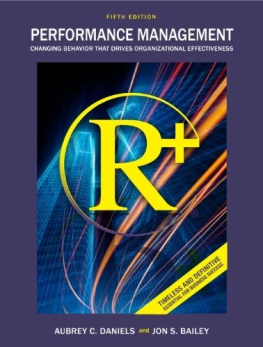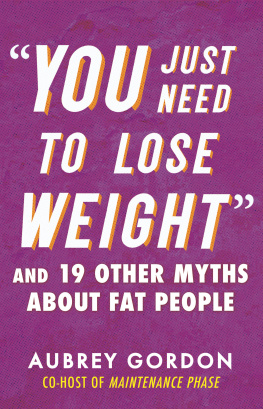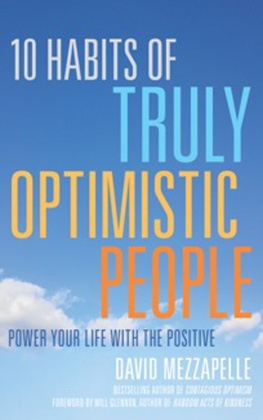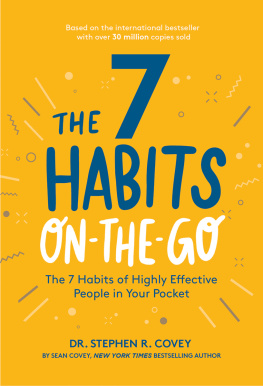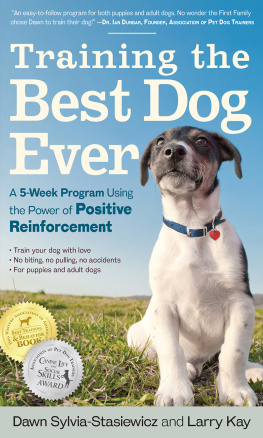Also by Aubrey C. Daniels:
Bringing Out the Best in People
Performance Management:
Changing Behavior that Drives Organizational Effectiveness
Measure of a Leader
Library of Congress Cataloging-in-Publication Data
Daniels, Aubrey C.
Other peoples habits : how to use positive reinforcement to bring out the best in people around you / Aubrey Daniels.
p. cm.
Includes index.
ISBN 0-937100-14-1 (alk. paper)
1. Behavior modification. 2. Reinforcement (Psychology) I. Title.
BF637.B4 D34 2000
158.2dc21
00-060925
Copyright 2007 by Performance Management Publications. All rights reserved. Printed in the United States of America. Except as permitted under the United States Copyright Act of 1976, no part of this publication may be reproduced or distributed in any form or by any means, or stored in a database or retrieval system, without the prior written permission of the publisher.
ISBN 978-0-937100-14-1
To my family Becky, Laura-Lee, and Joanna, who played a major role in shaping my habits. I am a far better person because of them.
CONTENTS
PREFACE
If it is true that knowledge is power, then knowledge of the laws of human behavior must be the most powerful information a person can possess. In the more than 40 years I have worked to improve the effectiveness of organizations, families, and people themselves, I have become convinced that the enormous power of the science and technology of behavior analysis can solve major interpersonal and societal problems.
Because my first two books were oriented toward management, many of our customers asked me when I was going to write a book for all employees. Those requests were the genesis of this book.
In the beginning my working title was Taking Charge of Your Life. I started out to write a book to help front-line employees solve interpersonal problems in the workplace. However, as I began writing I realized that it was not a book for front-line employees; it was for everybody. The causes of and solutions to interpersonal problems in the workplace are the same whether you are a clerk or the president of the company, a Sunday school teacher or the parent of a young child or teenager. The causes of and solutions to problems at home and in society are essentially no different from those in the workplace. As a result, this book is written for everybody everywhere.
In this book I have tried to write about the science of human behavior in a way that is interesting, understandable, and as true to the science as possible. To that end I have used many everyday stories about my experiences and those of my professional and business colleagues. I have avoided jargon as much as possible, but sometimes the only way to describe a situation in a manner that communicates clearly is to use the vernacular of the science. I believe you will find that as you get familiar with the few technical terms I have employed, those terms will enrich your understanding of the material and increase your ability to use your knowledge successfully.
To assist you in applying what you learn in this book, I have devoted the Appendix to a number of real-life examples that first appeared in our magazine, Performance Management. In those examples, people in all walks of life have successfully solved the widest variety of everyday problems, from family life and sports to government and the community, from the clinic to the classroom.
When you have finished reading this book, you will at the very least understand why people often behave in unusual ways and will have some new ideas about how you can help them and yourself make changes for the better.
Aubrey C. Daniels
ACKNOWLEDGMENTS

I would like to acknowledge the contributions of my family, business associates, and friends because without their stories this book would not have been possible. I would especially like to thank John Domenick, who, as in the past, has provided the encouragement and prodding (antecedents and consequences) necessary to bring a project like this to fruition. He has also edited the case studies in the Appendix and provided valuable hands-on assistance at every stage of this project. Joanne Donner read the manuscript many times, and her suggestions for change always improved the clarity of what I was trying to communicate. Finnur Oddsson and Guy Bruce read the manuscript and made many helpful technical suggestions. Finnur also did research that saved me many hours of work. Many of Gail Snyders articles from Performance Management magazine are included in the Appendix. Not only does she understand the principles and techniques of performance management, she writes in a way that is always clear and interesting.
A BETTER WAY
Many people lead bad lives that would gladly lead good ones, but do not know how to make the change.
LORD KAMES, 1760
Quoted in Benajamin Franklin, Poor Richards Almanac
L et me begin with a bold statement: Most of the worlds problems, from crime and drugs to ineffective education and the threats to world peace, result from a lack of understanding of how consequences change behavior.
While this book is about the science of behavior analysis in everyday life, it deals mostly with the effective use of positive reinforcement. Positive reinforcement is the most powerful interpersonal tool a person can use to improve a personal relationship, a family, a business, a community, or a nation, yet it is the most misunderstood and misused. Sad to say, most of what has been written about positive reinforcement is far from scientifically based and probably has done more harm than good.
In various ways and in various places throughout this book I will emphasize the point that the technology on which the book is basedbehavior analysisdiffers from most popular theories, programs, and systems in that it is a scientific approach to managing human behavior. It is a technology for achieving measurable, predictable results. However, to say that behavior analysis is a science and nothing more is like saying that Chateau Lafite is fermented grape juice, a statement which, though technically correct, is scarcely the way one would choose to describe a vintage Bordeaux wine.
Behavior analysis gives us the opportunity to master a powerful and effective technique with which to influence the people around us. Whether at work, at home, or at play, knowing how to deliver positive reinforcement enables us to make changes in our environment that weve been trying to make or wanting to make for years.


